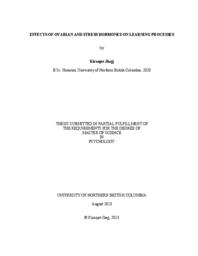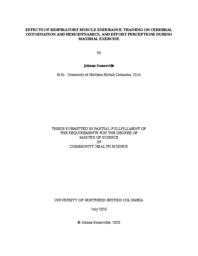Pettersen, Jacqueline
Person Preferred Name
Jacqueline Pettersen
Related Works
Content type
Digital Document
Description / Synopsis
Learning is controlled by two interacting processes, cognitive and habitual learning. How these two systems are used while we learn in our everyday lives depends on an individual’s context. For example, stress is one contextual factor that consistently has created a shift toward habitual learning. In addition, there is evidence that ovarian hormones can also influence learning processes. However, research investigating these hormonal influences has resulted in inconsistent findings. While there is evidence that both of these contextual factors influence learning processes, there is little research on what effects result from their interaction. Further, while the menstrual cycle is often used to approximate ovarian hormone levels in such studies, it is conceptualized strictly as a biological phenomenon, despite evidence supporting its biopsychosocial characterization. Thus, the current study investigated the individual and interactive effects of chronic stress and ovarian hormones on learning processes, while using a biopsychosocial understanding of the menstrual cycle. Participants (N = 32) completed a probabilistic classification learning task. They also provided salivary measures of estradiol and progesterone, and completed measures of chronic stress and menstrual-related attitudes and beliefs. Results revealed a trending association between progesterone and learning processes. Further, there was an interaction between chronic stress and estradiol in predicting learning process use. Lastly, there were significant correlations between learning processes and various menstrual beliefs. As such, these preliminary results revealed how ovarian hormones and chronic stress interact to influence learning processes, and menstrual attitudes and beliefs can provide a more detailed understanding of these effects.
Origin Information
Content type
Digital Document
Description / Synopsis
The primary objective of this study was to investigate the effects of a 4-week respiratory muscle endurance training (eRMT) program on the physiological and psychological aspects of central fatigue using, respectively, near-infrared spectroscopy (NIRS) and quantification of effort perceptions during maximal exercise. A secondary objective was to assess any impact of eRMT on respiratory health and exercise performance. This study compared pre- and post-eRMT data from the same group of healthy adults. The results indicated that eRMT did not have any effect on respiratory function, exercise time to exhaustion, or physiological responses to exercise but significantly decreased ratings of perceived exertion (RPE) during exercise. An increase in the concentrations of oxygenated hemoglobin [O2Hb], deoxygenated hemoglobin [HHb], and total hemoglobin [tHb] during exercise was observed post-eRMT compared to pre-eRMT, and this increase differed by hemisphere. Based on these preliminary findings, we suggest an eRMTinduced left-to-right hemodynamic shift during exercise, consistent with the change from a novel to a learned task.
Origin Information


